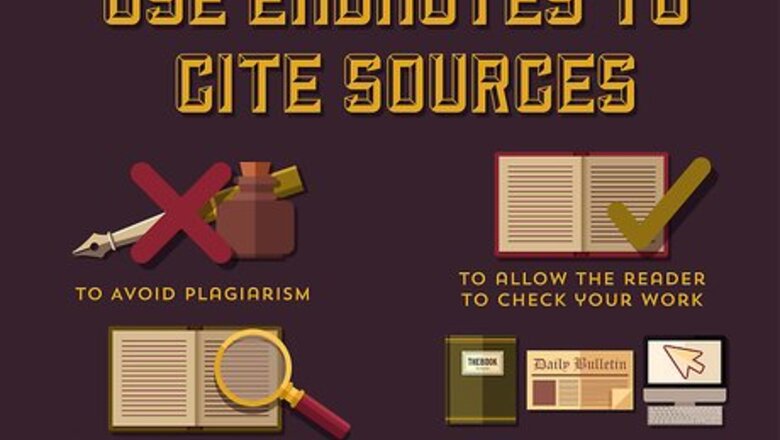
views
Inserting Endnotes
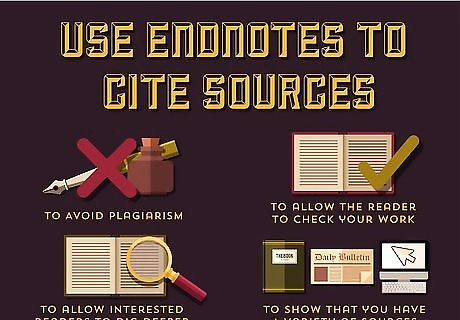
Use endnotes to cite sources. If the information or quote you are referencing in an academic paper or book comes from a source, you will need to give your reader the necessary information to look up the information in that source. This is done for a variety of reasons: To avoid plagiarism, you must correctly attribute ideas and quotations, which is using someone else's ideas or material without acknowledgement (intentionally or unintentionally). If you are a student, plagiarism may result in disciplinary action. If you are an academic or professional, plagiarism will result in, at best, the rejection of your manuscript, and at worst disciplinary action. People have even their degrees revoked when plagiarism was discovered. To allow the reader to check your work. Proper citations allow readers to look up the quotes and ideas you used in context, to see if they agree with your interpretation. To allow interested readers to dig deeper. Endnotes allow readers interested in your topic to easily locate the sources that informed it so that they can read them as well. To show that you have considered a variety of sources. Endnotes allow you to show the reader that you have considered all of the major arguments regarding your given topic, or if you have not, allows them to easily see which authors you have failed to consider.

Keep track of your sources as you research your paper. Because you will need to correctly cite your sources, it is important to keep track of all the pertinent information when taking notes. This includes: Page number Author name, as well as the name of any editors or translators Book name, place of publishing, name of publisher, and year of publishing if a book Article name, periodical name, volume and series number, and date of publication

Put endnotes at the end of your paper. Other systems cite sources parenthetically within the text or in footnotes at the bottom of the page. Endnotes, on the other hand, are all collected in a separate section labeled “Notes” at the end of your paper. There are advantage and disadvantages to this: Pushing citations to the end of a paper or work helps to create clean, uncluttered pages. This is why endnotes are often preferred in books. Having all the citations in one place allows the reader to digest them as a whole. On the other hand, not having citations on the page means the reader will have to flip to the back of your manuscript each time they want to look something up, which can be frustrating. Endnotes can give the impression that you are trying to hide your citations.

Insert note numbers in the text to reference your endnotes. You should insert a superscript number in your text immediately after you reference someone else’s work. The same number will appear in the endnote section at the end of your manuscript, allowing your reader to look up the citation. Note numbers should follow punctuation. Never put a note number before a period, comma, or quotation mark. Note numbers should be consecutive throughout an entire paper. In a book, note numbers may restart with each chapter, in which case the endnotes should be divided by chapter. Put the superscript number at the end of the clause or sentence in which you reference someone else's materials. For example: "According to Hoskins and Garrett, IQ tests are often problematic, but I argue that it is still possible to implement them usefully in school settings."

Create a separate endnotes page. Your endnotes should start on their own page, with “Notes” centered at the top. Each citation should start with a superscript number that matches the note number in the text where the material was cited. Indent the first line of each endnote half an inch (or 5 spaces) from the left margin. Additional lines within a single endnote should be flush with the left hand margin. Use the appropriate citation form per your style guide.

Pick a word processor that inserts notes and creates an automatic link to the endnotes page. While you can insert a superscript number yourself and then scroll to your endnotes page to write the note, it is much easier to use the Endnote Function in your word processor. In programs like Microsoft Word, you simply have to click Insert > Insert Endnote (or References > Insert Endnote, depending on your version). A number note will automatically be inserted into the text wherever your cursor is and you will be taken to the same note number on the endnotes page, where you can enter the citation information.
Using Chicago (Turabian) Style
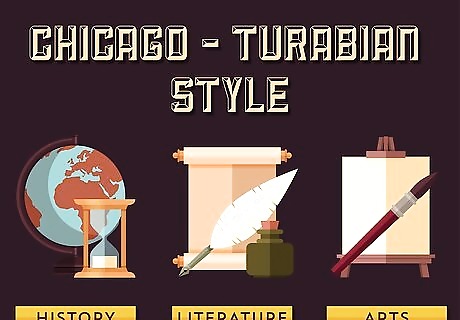
Use Chicago style mainly for history, but also sometimes for the literature and arts. The Chicago Style is also named Turabian after Kate Turabian, who wrote a style manual based on the Chicago Style while working at the University of Chicago. It is the only style used by historians. Chicago style uses endnotes (or footnotes) to cite sources, rather than providing inline citation. This is a key difference from MLA style, which uses inline citation. In Chicago style, it is recommended to always write the author name and title, not just the author name, in subsequent citations after the first full one. In Chicago style, a bibliography typically follows the endnotes. The bibliography lists all sources in alphabetical order by author’s last name. You should add entries to it every time you create a note. The format is slightly different from endnotes. See http://www.chicagomanualofstyle.org/tools_citationguide.html for more information.
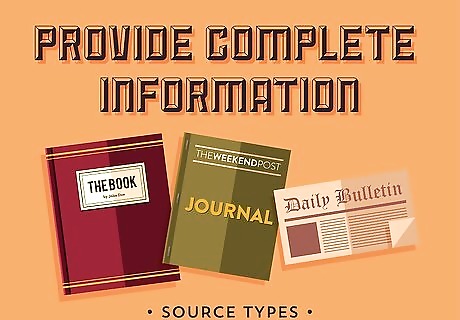
Provide complete information the first time you cite a work. The information required will vary depending on the type of source. Book (author) – Author’s First and Last Name, Title (Place of Publication: Publisher, Date of Publication), page number(s). Book (editor) – Author’s First and Last Name, ed., Title (Place of Publication: Publisher, Date of Publication), page number(s). Journal Article – Author’s First and Last Name, “Title of Article,” Title of Journal Volume (Year): page number(s). Newspaper – Author’s First and Last Name, “Title of Article,” Title of Newspaper, date, page number(s). For all source types, if there are two to three authors, list their names with commas between them. For more than three authors, write the first author's name, a comma, and “et al.” in place of any remaining authors. For a complete list of source types and their appropriate formats, see http://www.chicagomanualofstyle.org/tools_citationguide.html.
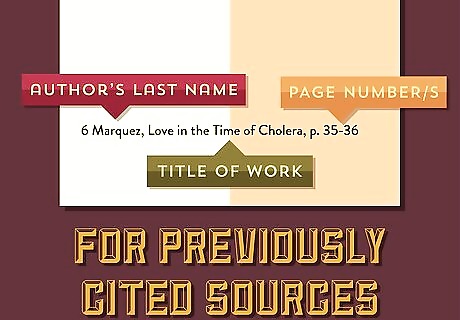
Use only the author’s name, the title, and the page number for previously cited sources. If you have already cited a source once, you do not need to give full citation information for future citations of the sources. Simply write: Author’s last name, Title, page number(s). (If the title is not fiction or poetry, you can use a shortened form of the title if it is longer than four words.)
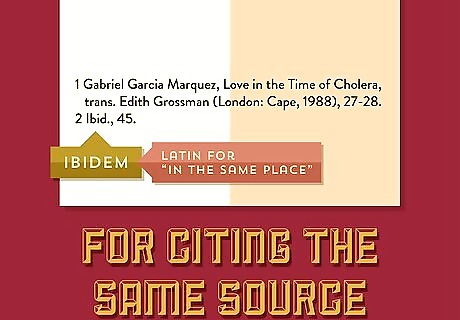
Write “ibid” if you are citing the same source in two or more consecutive endnotes. In this case, there is no need to write even the author’s name. You can replace all reference information with “ibid.”, short for ibidem, Latin for “in the same place.” For example, if citing Gabriel Garcia Marquez’s Love in the Time of Cholera twice in a row, you would write: 1 Gabriel Garcia Marquez, Love in the Time of Cholera, trans. Edith Grossman (London: Cape, 1988), 27-28. 2 Ibid., 45.
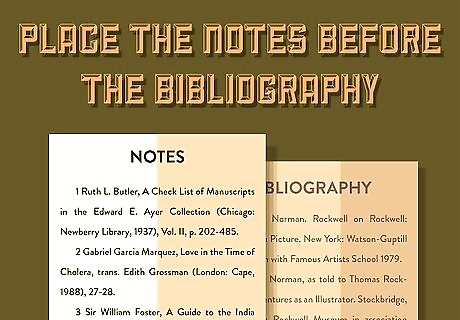
Place the Notes page just before the Bibliography. If you have any appendices, put the Notes page after those. Double-space the endnotes just as you double-space the manuscript. In some cases, your teacher may prefer you to single-space endnotes and leave a blank line between each entry. If you have questions, consult with your teacher.
Using MLA Style

Use MLA (Modern Language Association) style for work in the liberal arts and humanities. If you are going to use endnotes in a paper for a literature, philosophy, religion, art, or music class, you will usually need to follow the MLA style. MLA style does not recommend using endnotes to cite works. You should use inline citation in MLA style unless specifically told otherwise. In most cases, you will still need to provide a Works Cited page in addition to your endnotes.
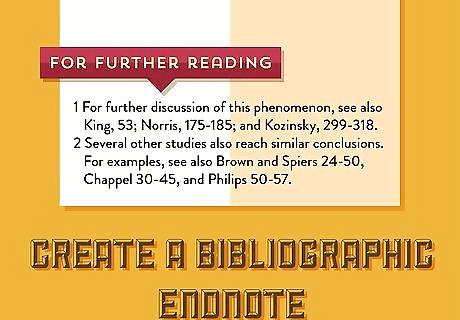
Create a bibliographic endnote. This type of endnote in MLA style allows you to refer to other texts your readers may wish to reference. This can be helpful if you have several sources that offer further reading on the topic you are discussing, but do not have room in your paper to discuss them all there. For example, "For further discussion of this phenomenon, see also King, 53; Norris, 175-185; and Kozinsky, 299-318." For example, "Several other studies also reach similar conclusions. For examples, see also Brown and Spiers 24-50, Chapel 30-45, and Philips 50-57."
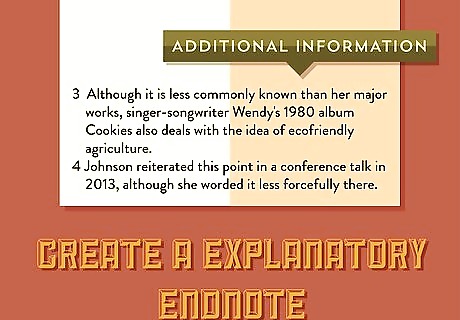
Create an explanatory endnote. Explanatory endnotes offer additional explanatory information, especially if it seems tangential to the main idea discussed in the paper. MLA recommends that you use this type of endnote sparingly. For example, "Although it is less commonly known than her major works, singer-songwriter Wendy's 1980 album Cookies also deals with the idea of ecofriendly agriculture." For example, "Johnson reiterated this point in a conference talk in 2013, although she worded it less forcefully there."

Place the Notes page before the Works Cited. In MLA style, place the Notes page immediately before the Works Cited page. Center the word Notes on the page. Do not use any formatting or quote marks. If you have only one endnote, use the word Note. Double-space endnotes in MLA style.



















Comments
0 comment